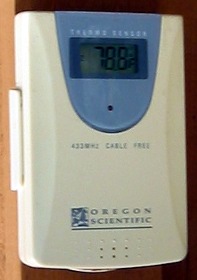Many Oregon Scientific do not have any PC interface (they are present in
WMR200 or I-900 but usally not available in cheaper ones). Their radio sensors transmit on 433.92 MHz sending data packets containing the data every 30 seconds using OOK and manchester encoding for 32 bits of data.
Kevin Mehall wrote Python script that decodes radio signal trasmitted by Oregon Scientific and captured with RTL-SDR (DVB-T tuner working as SDR hardware).
2012-04-30
2012-04-22
Precise DIY LC + ESR meter with ATmega88
This DIY meter allows pretty precise measurement of inductance (10 nH - 100 H), capacitance (1 pF - 100 mF) and low resistances or ESR (5 mOhm - 30 Ohm).
You can find project documentation or buy componets as a kit on dr. Le Hung site.
You can find project documentation or buy componets as a kit on dr. Le Hung site.
2012-04-17
Dual-channel USB oscilloscope/recorder
This simple USB oscilloscope allows continuous data recording at 2x300 kSps, 8 bit. Although it has very reduced analog part (low input impedance, no gain switch, only single 0-6.6V measurement range) it could be worlds third cheapest dual channel oscilloscope (right after sound card and this AVR circuit). It is based on STM32F103C8T6 - Cortex M3 microcontroller with Full-Speed USB costing around $4.
PCB dimensions: 66 x 36 mm, total cost 8 - 10 USD.
It works with miniscope v4 PC software:
Updated (2012.04.29) firmware makes use of both A/D converters allowing to increase input impedance (no crosstalk between channels). Sampling speed is increased to 2x461 kSps and S/H time is increased from 7.5 cycles to 13.5 cycles.
ADCs can still work faster, but this is most likely maximum speed that can be handled by USB full-speed and real time streaming is most important feature here allowing to use i.e. 2x128 k sample buffer with MCU that has much less RAM and store to file continuous stream up to 10^9 samples (limited by used file format). While this circuit can not by any means compete with bench oscilloscopes in sampling speed category it can beat even expensive ones in terms of sampling buffer size using up to 4 GB of disk space to capture waveform.
2012-04-14
STM32 F0 series seminars in North America
From ST: "STM32 F0 microcontrollers are sampling now at the resale price of $0.95 for quantities of 1000 pieces to lead customers. Full production is scheduled for the beginning of Q2 2012, and the devices will be available in 32-pin UFQFPN32, 48-pin LQFP48 and 64-pin LQFP64 package options with 20-pin and 100-pin extensions soon to follow."
Same as when introducing Cortex-M3 or F4 microcontrollers, ST Microelectronics is organizing educational seminars - currently scheduled in North America in May and June. Free STM32 F0 Discovery Kit is on the menu. Dates and locations:
Same as when introducing Cortex-M3 or F4 microcontrollers, ST Microelectronics is organizing educational seminars - currently scheduled in North America in May and June. Free STM32 F0 Discovery Kit is on the menu. Dates and locations:
| 16.05.2012 | Vancouver | |
| 17.05.2012 | Seattle | |
| 22.05.2012 | Santa Clara | |
| 22.05.2012 | Cleveland | |
| 24.05.2012 | Dallas | |
| 29.05.2012 | Montreal | |
| 31.05.2012 | Toronto | |
| 5.06.2012 | Atlanta | |
| 5.06.2012 | Chicago | |
| 7.06.2012 | Minneapolis | |
| 7.06.2012 | Orlando | |
| 12.06.2012 | Orange County | |
| 14.06.2012 | San Diego | |
| 19.06.2012 | Boston | |
| 21.06.2012 | Philadelphia | |
| 28.06.2012 | Phoenix |
Retro electronics: recording in stereo with acoustic head model
One more clipping from '70s magazine "Юный Техник". Article describes stereo recording technique using acoustic human head model with attached microphones - whole idea is pretty clean explained by picture. According to it this method results in very precise spatial reproduction when listening to records. The drawback is that these records should be listened using headphones.
Subscribe to:
Comments (Atom)



